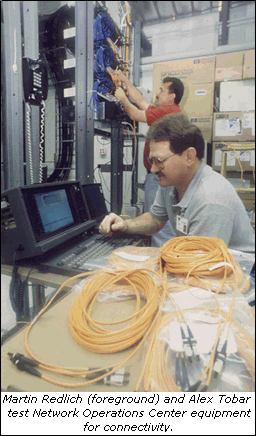
Volume 5, No 8
 Information Technology News of the University of California, Davis
Information Technology News of the University of California, Davis  Summer 1997
Summer 1997

 Information Technology News of the University of California, Davis
Information Technology News of the University of California, Davis  Summer 1997
Summer 1997
Network 21 Update
ATM Chosen as Network 21 ElectronicsOn July 9, the Network 21 Oversight Committee accepted the recommendation of its technical subcommittee to designate ATM, or Asynchronous Transfer Mode, as the technology of choice for the Network 21 electronics. The decision was made within the two-month time frame designated at the Think Tank session in May.At the two-day Think Tank, technical experts from five UC campuses (including UC Davis) and Stanford analyzed the possibilities for Network 21 electronics and narrowed the choice to two options: fast ethernet and ATM. The technical subcommittee used the Think Tank recommendations to perform a detailed evaluation, which showed distinct advantages of ATM. While ATM is the more expensive option, the additional cost is anticipated to buy longevity in the network infrastructure. ATM is easier than fast ethernet to upgrade, making improvements to the backbone less costly in the future. With the choice made, bid specifications can be detailed. Next, criteria will be developed for multiple pilots, along with performance criteria by which the pilots will be evaluated. Implementation of the final stage of Network 21 (Stage 3) is planned for February 1998, for an October 1998 completion date. For an overview of the re-evaluation process, see http://net21.ucdavis.edu/Reev.htm. More detailed information, together with a glossary of terms, may be found at http://net21.ucdavis.edu/assess.htm. E-mail comments, questions, and concerns to net21electron@ucdavis.edu. Town Hall MeetingMembers of the Network 21 Oversight Committee and Network 21 project directors led a Town Hall Meeting on July 8 for the campus community to discuss and provide input into the Network 21 electronics plan. Jay Lund, chair of the Oversight Committee's technical subcommittee, reviewed the history and mission of the re-evaluation process. Russ Hobby, one of the architects of the original Network 21 design, described in detail the Think Tank evaluation process and enumerated its recommendations:

Lund explained that the technical subcommittee used two levels of criteria to evaluate and compare the various technologies. First they applied screening criteria in order to narrow down the 22 options to those that were acceptable. These criteria were based on functionality (including the requirement that Virtual LANs (VLANs) be supported) and cost (requiring that it remain within the $23 million cap for the entire Network 21 project). The choices remaining after applying these criteria still provided for both a Fast Ethernet or an ATM solution. Next, ranking criteria were applied. In comparing ATM and fast ethernet on the bases of cost, bandwidth, functionality, operability, and risks, ATM ranked higher in nearly all categories. The primary exception was cost. While the costs used in the analysis were estimates, rather than those of bidding vendors, it was proposed that the cost for ATM would be an additional $700,000. (For more details about the ranking criteria, see http://net21.ucdavis.edu/assess.htm.) Switching to the Fiber-Optic BackboneNetwork 21 technicians are in the process of cutting over campus users to the fiber-optic infrastructure. To date, approximately 4,000 users previously connected to UCDNet have been connected to the fiber backbone. All users in previously unconnected buildings in Network 21-designated Areas have been cut over as have all DaFIS users. Another group of nearly 1,000 "problem LAN" users were connected via switched 10BASE-T technology in late June. These users have reported a notable increase in the speed of their connections. Network 21 technicians will spend the next two and a half months on ResNet, connecting approximately 3,750 residence hall NAMs to the backbone using switched 10BASE-T technology. ResNet connections are expected to be complete by mid-October. The next phase will connect approximately 2,000 unconnected users in connected buildings. All users in the Network 21 Areas will be connected to the fiber-optic infrastructure by Thanksgiving. This will pave the way for Stage 3 of the Network 21 project (the implementation of ATM electronics) in early 1998. |